
On this month's Morbidly Fascinating Page:
The Bog Bodies

Toland Man (above)

Above is a map showing where the bodies were found
What is a Bog Body?
A bog body is a human cadaver that has been naturally mummified in a peat bog. Such bodies, sometimes known as bog people, are both geographically and chronologically widespread, having been dated to between 8000 BCE and as recently as 2003. The unifying factor of the bog bodies is that they have been found in peat and are partially preserved; however, the actual levels of preservation vary widely from perfectly preserved to mere skeletons.
Unlike most ancient human remains, bog bodies often retain their skin and internal organs due to the unusual conditions of the surrounding area. These conditions include highly acidic water, low temperature, and a lack of oxygen which combine to preserve but severely discolor their skin, making them seem like they had a tan. While the skin is well-preserved, the bones are generally not, due to the acid in the peat having dissolved the calcium phosphate of bone.
The vast majority of the bog bodies that have been discovered date from the Iron Age, a period of time when peat bogs covered a much larger area of northern Europe. Many of these Iron Age bodies bear a number of similarities, indicating a known cultural tradition of killing and depositing these people in a certain manner. These Pre-Roman Iron Age people lived in sedentary communities, who had built villages, and whose society was hierarchical.
Many bog bodies show signs of being stabbed, bludgeoned, hanged, or strangled, or a combination of these methods. In some cases the individual had been beheaded. In the case of the Osterby Man found at Kohlmoor, near Osterby Germany in 1948, the head had been deposited in the bog without its body.
Most of these bog bodies were murder victims.
See HERE
Why were these bodies found in peat bogs?

Ever since the Iron Age, humans have used the bogs to harvest peat, a common fuel source. On various occasions throughout history, that is why peat diggers have come across bog bodies.
Below are photographs of Bog Bodies
Clonycaven Man

Clonycaven Man
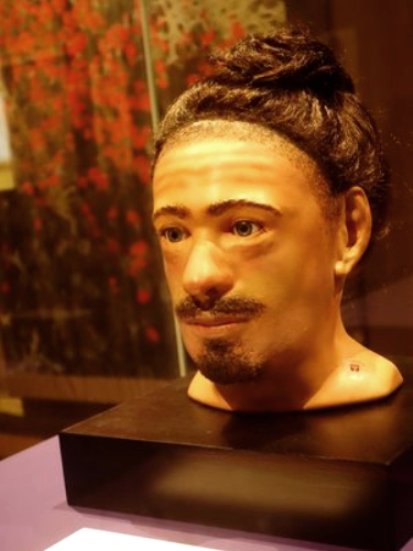
Rendition of how Clonycaven Man may have appeared in life
Clonycavan Man is the name given to a well-preserved Iron Age Bog Body found in Clonycavan, Ireland in March 2003. Only Clonycavan Man's head and torso are preserved. He was found in a modern peat harvesting machine, which was possibly responsible for the severing of his lower body.
The scientific study of Clonycavan Man's hair has shed light on his diet leading up to his death. His diet was rich in vegetables and proteins, which indicates that he may have been killed during the warmer summer months of the year. Clonycavan Man was also fairly young at the time of his death; he is believed to have been in his early twenties.
The most distinguishing feature of the man was his hairstyle, which was raised upon his head with the help of a "hair gel" made of plant oil and pine resin. Remnants of a hair tie was also found on the corpse so Clonycaven Man may have sported the original "man-bun."
Clonycavan Man is believed to have been murdered, based on an examination of the evidence found on his body by the Garda Technical Bureau (Irish Police Forensic Division). His skull looks to have been split open by a sharp implement.
Bockston Man
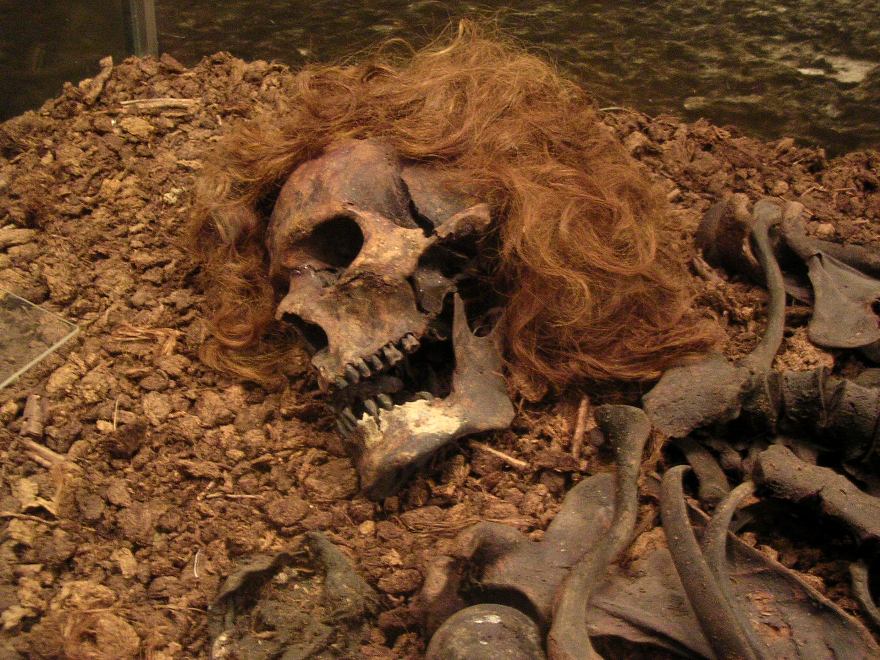
Bockston Man
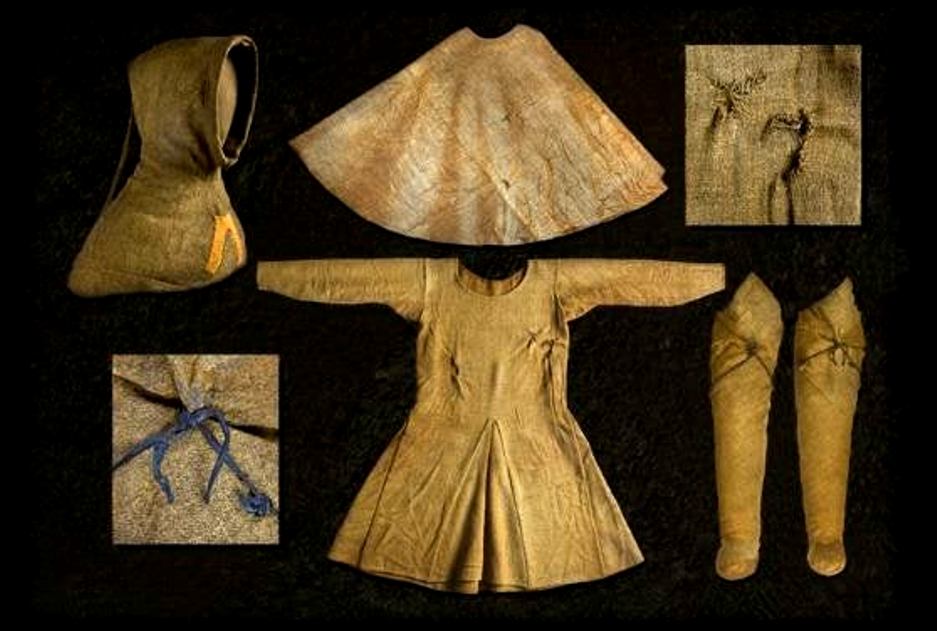
Bockston Man Clothing


What Bockston Man may have looked like in life
The Bocksten Man (Bockstensmannen) is the remains of a medieval man's body found in Varberg, Sweden. It is one of the best-preserved finds in Europe from that era.
The man was 170–180 centimetres (5 ft 7 in – 5 ft 11 in) tall and of slender build. There is an injury covering about 8 by 5 centimetres (3 in × 2 in) on the right side of the cranium. Of the inner organs, parts of the lungs, liver, and brain as well as cartilage are preserved. The man had been impaled to the lake bed with two poles; one of oak that hit his heart and one of beech which went through his back.
The tunic is among the best-preserved medieval tunics in Europe and is made of wool.
Based on the teeth, Gunnar Johansson, foresnsic odontologist and department head of the Faculty of Odontology at Karolinska Institute, has concluded that the man was between 25 and 35 years old when he died. Based on the skeleton, osteologist Nils-Gustaf Gevall (1911–1991) of Stockholm University, came up with an age of between 35 and 40 years,
A hypothesis has been presented that the person was Simon Gudmundi, the dean of the Diocese of Linkoping, who died on 12 May 1491. In his 1998 book, Vem var Bockstensmannen? (Who was the Bocksten Man?), Owe Wennerholm reasoned that Gudmundi's name fit with what might be initials found on what might be a micro shield. It is also likely that Gudmundi visited the area.
Grauballe Man


Grauballe Man

A rendition of Grauballe Man in life
Information about the Grauballe Man's life has been ascertained from his remains. His hands were smooth and did not show evidence of hard work, indicating that Grauballe Man was not employed in hard labor. Study of his teeth and jaws indicate that he had suffered from "periods of starvation or a poor state of health during his early childhood."
The man's skeleton showed signs of significant calcium deficiency, and his spine also suffered the early stages of spondylosis deformans, a generalized disease of ageing that is secondary to the degeneration of intervertebral disks. Due to the shrinkage that the corpse suffered in the bog, the man's actual height is not known. What is known is that he had dark hair.
Tolland Man



Tolland Man

Rendition of how Tolland Man may have appeared in life
The Tollund Man (died 405–384 BCE) is a naturally mummified corpse of a man who lived during the 5th century BCE, during the period characterised ias the Pre-Roman Iron Age. He was found in 1950, preserved as a bog body on the Jutland peninsula in Denmark. The man's physical features were so well preserved that he was initially mistaken for a recent murder victim. The cause of death has been determined to be hanging.
The Silkeborg Museum estimated his age as approximately 40 years and height at 1.61 m (5 ft 3 in), a relatively short stature even for the time.
The stomach and intestines were examined and tests were carried out on their contents. Scientists identified the man's last meal as porridge or gruel made from grains and seeds, both cultivated and wild. Approximately 40 kinds of seeds were identified, but the porridge was primarily composed of four types: barley, flax, false flax and knotgrass.
Porridges were common for people of this time. Because neither meat nor fresh fruit was found in the last meal, it is suggested that the meal was eaten in winter or early spring when these items were not easily available.
Both feet and the right thumb, being well conserved by the peat, were also preserved in formalin for later examination. In 1976, the Danish police made a fingerprint analysis, making Tollund Man's thumbprint one of the oldest prints on record.
Lindow Man
.jpg)
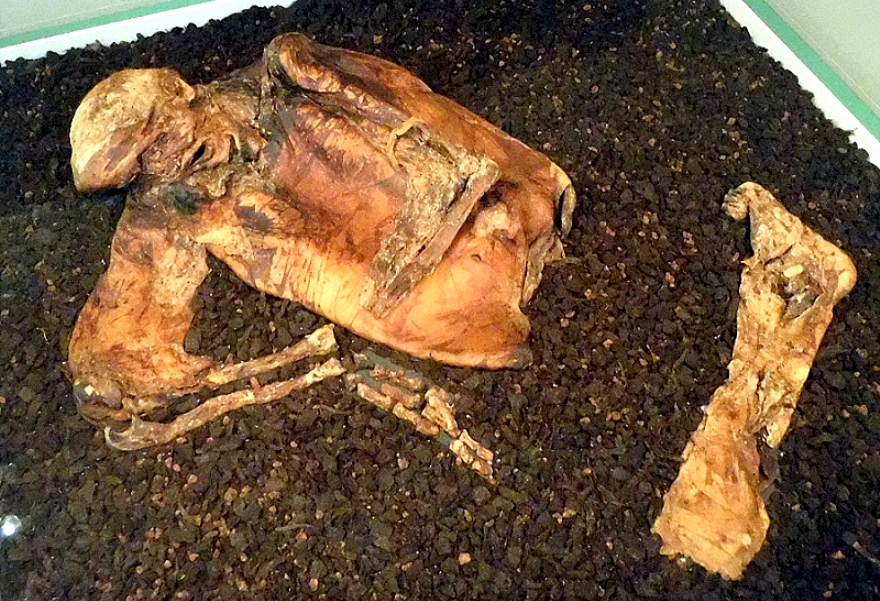
Lindow Man

Lindow Man as he may have appeared in life
Lindlow Man was discovered in a peat bog near Cheshire, North West England. The remains were found on 1 August 1984 by commercial peat cutters.
Dating the body of Lindow Man has proven problematic, but it is thought that he was deposited into Lindow Moss, face down, sometime between 2 BC and 119 AD, in either the Iron Age or the Romano-British period. At the time of death, Lindow Man was a healthy male in his mid-20s, and may have been of high social status as his body shows little evidence of having done heavy or rough physical labor during his lifetime. There has been debate over the reason for his death; his death was violent and perhaps ritualistic.
In life, Lindow Man would have been between 5'6" and 5'8" (168 and 173 cm) tall and weighed about 132 pounds (60 kg). The body retains a trimmed beard, moustache, and sideburns of brown hair, as well as healthy teeth with no visible cavities, and manicured fingernails, indicating he did little heavy or rough work. Apart from a fox-fur armband, Lindow Man was discovered completely naked. When he died, Lindow Man was suffering from slight osteoarthritis and an infestation of whipworm and maw worm.
Are there any female bog bodies?
Yes, but not nearly as many as male bog bodies. Below are two examples of female bog bodies.

Huldremose Woman
Found in 1879 in a peat bog in Jutland, Denmark, this female bog body is believed to have lived during the Iron Age. Her mummified remains are on display at the National Museum of Denmark. The elaborate clothing worn by Huldremose Woman has been reconstructed and displayed at several museums.
The body was found with the legs bent and a nearly severed right arm. It is thought that the arm was damaged before she died.
Yde Girl
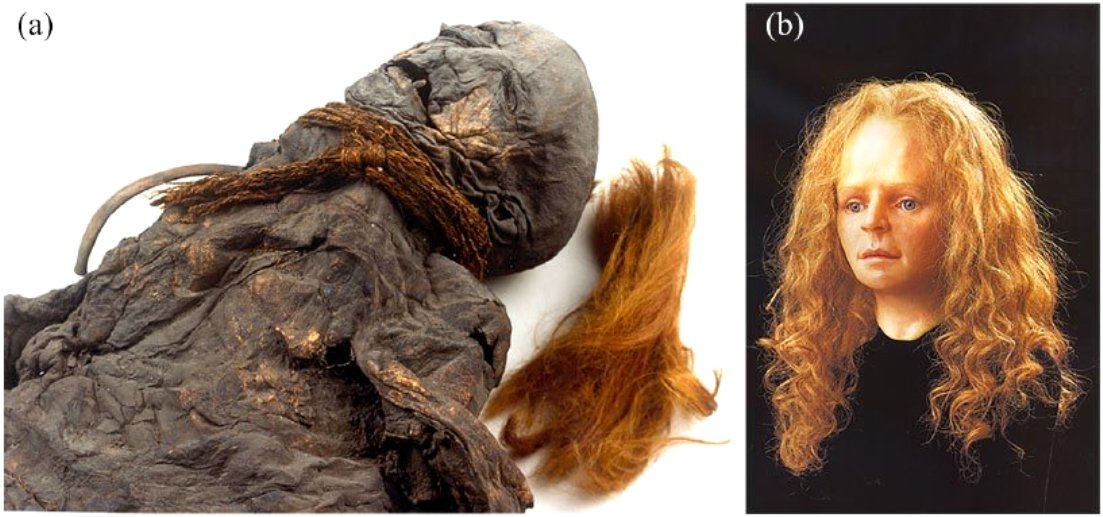
The Yde Girl was found in the Stijfveen peat bog near the village of Yde in the Netherlands. She was found on 12 May 1897 and was reputedly uncannily well-preserved when discovered (especially her hair), but by the time the body was turned over to the authorities two weeks later, it had been severely damaged and deteriorated.
Carbon-14 tests have indicated that Yde Girl died between 54 BC and 128 AD at an approximate age of 16 years. She had long, reddish-blonde hair, but one side of her head was initially thought to have been shaved before she died. Recent studies of Windeby I, however, have suggested that the shaved hair phenomenon in some bog bodies may simply attest to one side of the head being exposed to oxygen slightly longer than the other.
Scans have shown that she suffered from scoliosis. She stood at 137 centimetres (4 ft 6 in), which is comparatively small for a sixteen-year-old even in those days.
Are all the bog bodies in museums?
Throughout the 18th and 19th centuries, when such bodies were discovered, they were often removed from the bogs and given a Christian burial on consecrated church ground in keeping with the religious beliefs of the community who found them. These bodies were often assumed to be relatively modern victims. That means that most of the bog bodies found in the 18th and 19th century are buried and lost to history.
With the rise of antiquarianism in the 19th century, some people began to speculate that many of the bog bodies were not recent murder victims but were ancient in origin and were turned over to museums.
Here are a few museums that display bog bodies:
DENMARK: Grauballe Man, The Forhistorisk Museum
DENMARK: Tolland Man, The Silkeborg Museum
GERMANY: Neu England Man, Landesmuseum für Natur und Mensch
ENGLAND: Lindow Man, The British Museum in London
THE NETHERLANDS. Yde Girl, The Drents Museum
SWEDEN: Bockston Man, The Hallands Kulturhistoriska Museum (Halland Museum of Cultural History)